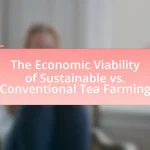The article focuses on evaluating carbon footprint reduction strategies in tea manufacturing, highlighting the importance of optimizing energy use, implementing sustainable agricultural practices, and enhancing waste management. It discusses the significant impact of tea production on carbon emissions and the necessity for effective strategies to mitigate these effects. Key components such as energy efficiency, sustainable sourcing, and waste management are examined, along with the challenges and economic barriers faced by manufacturers. The role of technology, consumer engagement, and industry standards in promoting sustainability within the tea sector is also addressed, providing a comprehensive overview of current practices and future trends in carbon footprint reduction.

What are Carbon Footprint Reduction Strategies in Tea Manufacturing?
Carbon footprint reduction strategies in tea manufacturing include optimizing energy use, implementing sustainable agricultural practices, and enhancing waste management. Optimizing energy use involves transitioning to renewable energy sources, such as solar or wind, which can significantly lower greenhouse gas emissions. Sustainable agricultural practices, such as organic farming and agroforestry, reduce reliance on chemical fertilizers and pesticides, thus minimizing environmental impact. Additionally, enhancing waste management through recycling and composting can decrease landfill contributions and promote a circular economy. These strategies collectively contribute to a more sustainable tea manufacturing process, aligning with global efforts to combat climate change.
Why is it important to evaluate carbon footprint reduction strategies?
Evaluating carbon footprint reduction strategies is crucial for identifying effective methods to minimize greenhouse gas emissions in tea manufacturing. This evaluation allows manufacturers to assess the impact of various practices, such as sustainable farming techniques and energy-efficient processing, on overall emissions. For instance, a study by the Food and Agriculture Organization indicates that implementing sustainable agricultural practices can reduce emissions by up to 30%. By systematically evaluating these strategies, tea manufacturers can make informed decisions that not only enhance sustainability but also improve operational efficiency and meet regulatory requirements.
What impact does tea manufacturing have on carbon emissions?
Tea manufacturing significantly contributes to carbon emissions primarily through energy consumption and agricultural practices. The process involves various stages, including cultivation, processing, and transportation, each generating greenhouse gases. For instance, a study published in the Journal of Cleaner Production found that tea cultivation and processing can emit approximately 1.5 to 2.5 tons of CO2 equivalent per hectare annually, largely due to the use of fossil fuels and fertilizers. Additionally, transportation of tea products adds to the carbon footprint, with emissions varying based on distance and mode of transport. Therefore, the overall impact of tea manufacturing on carbon emissions is substantial, necessitating strategies for reduction.
How do carbon footprints affect the environment and climate change?
Carbon footprints significantly contribute to environmental degradation and climate change by increasing greenhouse gas emissions, primarily carbon dioxide, into the atmosphere. These emissions result from various human activities, including energy production, transportation, and industrial processes, which are prevalent in sectors like tea manufacturing. According to the Intergovernmental Panel on Climate Change (IPCC), the accumulation of greenhouse gases leads to global warming, causing shifts in weather patterns, rising sea levels, and increased frequency of extreme weather events. Specifically, the tea industry, through its carbon-intensive practices, exacerbates these issues, highlighting the urgent need for effective carbon footprint reduction strategies to mitigate environmental impacts and combat climate change.
What are the key components of carbon footprint reduction strategies?
The key components of carbon footprint reduction strategies include energy efficiency, sustainable sourcing, waste management, and carbon offsetting. Energy efficiency involves optimizing processes to reduce energy consumption, such as using renewable energy sources and improving machinery efficiency. Sustainable sourcing focuses on obtaining raw materials from environmentally responsible suppliers, which minimizes emissions associated with transportation and production. Waste management entails reducing, reusing, and recycling materials to lower landfill contributions and associated greenhouse gas emissions. Carbon offsetting involves investing in projects that capture or reduce carbon emissions, such as reforestation or renewable energy initiatives, to balance out unavoidable emissions. These components collectively contribute to a comprehensive approach to reducing carbon footprints in various industries, including tea manufacturing.
What technologies are available for reducing carbon emissions in tea manufacturing?
Technologies available for reducing carbon emissions in tea manufacturing include energy-efficient processing equipment, renewable energy sources, and precision agriculture techniques. Energy-efficient equipment, such as improved drying machines and steam boilers, can significantly lower energy consumption and emissions during processing. Utilizing renewable energy sources, like solar or wind power, can replace fossil fuels in production, further decreasing carbon footprints. Precision agriculture techniques, including soil health monitoring and optimized irrigation, enhance crop yields while minimizing resource use, thus contributing to lower emissions. These technologies collectively support sustainable practices in the tea industry, aligning with global efforts to combat climate change.
How can sustainable farming practices contribute to carbon footprint reduction?
Sustainable farming practices contribute to carbon footprint reduction by enhancing soil health, improving biodiversity, and optimizing resource use. These practices, such as crop rotation, cover cropping, and reduced tillage, increase carbon sequestration in the soil, which can store significant amounts of carbon dioxide. For instance, a study published in the journal “Agriculture, Ecosystems & Environment” found that implementing cover crops can sequester up to 1.1 tons of carbon per hectare annually. Additionally, sustainable practices reduce reliance on synthetic fertilizers and pesticides, which are energy-intensive to produce and apply, thereby lowering greenhouse gas emissions associated with their use. By fostering a more resilient ecosystem, sustainable farming also mitigates the impacts of climate change, further contributing to overall carbon footprint reduction.
What challenges exist in implementing these strategies?
Implementing carbon footprint reduction strategies in tea manufacturing faces several challenges, including high initial costs, resistance to change among stakeholders, and the complexity of supply chain management. High initial costs can deter manufacturers from adopting new technologies or practices, as investments in energy-efficient equipment or sustainable sourcing may require significant capital. Resistance to change often arises from workers and management who may be accustomed to traditional methods, leading to a lack of buy-in for new strategies. Additionally, the complexity of supply chain management complicates the implementation of these strategies, as coordinating with multiple suppliers and ensuring compliance with sustainability standards can be logistically challenging. These factors collectively hinder the effective adoption of carbon reduction initiatives in the tea industry.
What are the economic barriers to adopting carbon reduction technologies?
The economic barriers to adopting carbon reduction technologies include high initial investment costs, lack of financial incentives, and uncertainty regarding return on investment. High initial costs deter many tea manufacturers from implementing these technologies, as they often require significant capital outlay for equipment and infrastructure upgrades. Additionally, the absence of robust financial incentives, such as subsidies or tax breaks, limits the motivation for businesses to transition to greener practices. Uncertainty about the long-term financial benefits further complicates decision-making, as companies may be hesitant to invest in technologies that do not guarantee immediate or clear returns. According to a report by the International Renewable Energy Agency, the upfront costs of renewable energy technologies can be a significant barrier, especially for small and medium-sized enterprises in the tea industry.
How do regulatory frameworks influence carbon footprint reduction in tea manufacturing?
Regulatory frameworks significantly influence carbon footprint reduction in tea manufacturing by establishing standards and guidelines that promote sustainable practices. These frameworks often mandate emissions reporting, incentivize the adoption of renewable energy sources, and encourage the implementation of efficient agricultural techniques. For instance, regulations such as the European Union’s Green Deal aim to reduce greenhouse gas emissions across various sectors, including agriculture, by setting specific targets and providing financial support for eco-friendly practices. This creates a structured environment where tea manufacturers are compelled to innovate and adopt practices that lower their carbon emissions, ultimately leading to a more sustainable industry.
How can tea manufacturers measure the effectiveness of their strategies?
Tea manufacturers can measure the effectiveness of their strategies by analyzing key performance indicators (KPIs) related to carbon footprint reduction, such as greenhouse gas emissions per unit of tea produced. By implementing a baseline measurement of their current carbon emissions, manufacturers can track changes over time after adopting new strategies. For instance, a study by the International Tea Committee found that implementing energy-efficient practices can reduce emissions by up to 30%. Additionally, manufacturers can utilize life cycle assessments (LCAs) to evaluate the environmental impact of their entire production process, providing concrete data on improvements. Regular audits and stakeholder feedback can further validate the effectiveness of these strategies, ensuring continuous improvement in sustainability efforts.
What metrics are used to assess carbon footprint reduction?
Metrics used to assess carbon footprint reduction include greenhouse gas emissions measured in carbon dioxide equivalents (CO2e), energy consumption metrics, and life cycle assessment (LCA) results. Greenhouse gas emissions provide a quantifiable measure of the total emissions produced, allowing for direct comparison before and after reduction efforts. Energy consumption metrics track the amount of energy used in production processes, which correlates with emissions levels. Life cycle assessments evaluate the environmental impact of a product from raw material extraction to disposal, offering a comprehensive view of carbon footprint reduction across the entire supply chain. These metrics are essential for accurately measuring the effectiveness of carbon reduction strategies in tea manufacturing.
How can data analytics improve the evaluation of reduction strategies?
Data analytics can enhance the evaluation of reduction strategies by providing actionable insights through data-driven decision-making. By analyzing historical data on carbon emissions, production processes, and resource usage, manufacturers can identify patterns and inefficiencies that contribute to their carbon footprint. For instance, a study published in the Journal of Cleaner Production found that data analytics enabled tea manufacturers to reduce energy consumption by 15% through optimized scheduling and resource allocation. This evidence demonstrates that leveraging data analytics not only improves the accuracy of evaluating reduction strategies but also facilitates continuous improvement in sustainability efforts within the tea manufacturing sector.

What specific strategies can be employed in tea manufacturing?
Specific strategies that can be employed in tea manufacturing include implementing sustainable agricultural practices, optimizing energy use, and enhancing waste management systems. Sustainable agricultural practices, such as organic farming and agroforestry, reduce chemical inputs and promote biodiversity, which can lower the carbon footprint. Optimizing energy use through renewable energy sources, like solar or wind, can significantly decrease greenhouse gas emissions associated with production. Additionally, enhancing waste management systems by recycling and composting can minimize waste and reduce emissions from landfills. These strategies collectively contribute to a more sustainable and environmentally friendly tea manufacturing process.
How can energy efficiency be improved in tea processing?
Energy efficiency in tea processing can be improved by implementing advanced technologies such as energy-efficient machinery, optimizing drying processes, and utilizing renewable energy sources. For instance, the use of solar dryers can significantly reduce energy consumption compared to traditional methods, as they harness solar energy for drying tea leaves. Additionally, upgrading to energy-efficient boilers and steam systems can lower fuel consumption and emissions. Research indicates that integrating these technologies can lead to energy savings of up to 30% in tea processing facilities, thereby contributing to a reduced carbon footprint.
What role does renewable energy play in reducing carbon footprints?
Renewable energy plays a crucial role in reducing carbon footprints by providing cleaner alternatives to fossil fuels, which are the primary source of greenhouse gas emissions. The use of renewable energy sources, such as solar, wind, and hydroelectric power, significantly lowers carbon emissions associated with energy production. For instance, according to the International Renewable Energy Agency (IRENA), transitioning to renewable energy could reduce global carbon dioxide emissions by up to 70% by 2050. This shift not only mitigates climate change but also enhances sustainability in industries, including tea manufacturing, by decreasing reliance on carbon-intensive energy sources.
How can waste management practices be optimized for lower emissions?
Waste management practices can be optimized for lower emissions by implementing strategies such as waste segregation, composting, and anaerobic digestion. Waste segregation reduces the volume of organic waste sent to landfills, which in turn decreases methane emissions, a potent greenhouse gas. Composting organic waste transforms it into nutrient-rich soil amendments, further reducing landfill reliance and associated emissions. Anaerobic digestion captures methane from organic materials, converting it into biogas for energy use, thus minimizing emissions from waste decomposition. According to the U.S. Environmental Protection Agency, effective waste management practices can reduce greenhouse gas emissions by up to 50% in certain contexts, demonstrating the significant impact of these strategies on lowering emissions in waste management.
What are the benefits of adopting sustainable sourcing practices?
Adopting sustainable sourcing practices in tea manufacturing significantly reduces the carbon footprint associated with production. These practices often involve sourcing materials from local suppliers, which minimizes transportation emissions and supports local economies. For instance, a study by the World Wildlife Fund found that local sourcing can reduce transportation-related carbon emissions by up to 30%. Additionally, sustainable sourcing promotes the use of environmentally friendly farming techniques, which can enhance soil health and biodiversity, further contributing to lower greenhouse gas emissions. By implementing these practices, tea manufacturers not only improve their environmental impact but also align with consumer demand for ethically produced products, potentially increasing market share and profitability.
How does sourcing from local suppliers impact carbon emissions?
Sourcing from local suppliers significantly reduces carbon emissions by minimizing transportation distances. When tea manufacturers procure ingredients from nearby sources, they decrease the fuel consumption associated with long-distance shipping, which is a major contributor to greenhouse gas emissions. For instance, a study by the Carbon Trust indicates that transportation can account for up to 30% of a product’s total carbon footprint. By choosing local suppliers, tea manufacturers can lower their overall carbon emissions, thereby contributing to more sustainable production practices.
What certifications can help ensure sustainable sourcing in tea manufacturing?
Certifications that can help ensure sustainable sourcing in tea manufacturing include Rainforest Alliance, Fair Trade, and USDA Organic. Rainforest Alliance certification focuses on environmental protection and sustainable farming practices, ensuring that tea is sourced from farms that meet rigorous sustainability standards. Fair Trade certification guarantees that producers receive fair compensation and promotes sustainable farming methods, which contribute to social and environmental sustainability. USDA Organic certification ensures that tea is grown without synthetic pesticides or fertilizers, promoting ecological balance and biodiversity. These certifications collectively support sustainable sourcing by enforcing standards that protect both the environment and the rights of workers in the tea industry.
How can consumer engagement enhance carbon footprint reduction efforts?
Consumer engagement can enhance carbon footprint reduction efforts by fostering sustainable practices and encouraging responsible consumption among tea consumers. Engaged consumers are more likely to support brands that prioritize eco-friendly production methods, which can lead to increased demand for sustainably sourced tea. For instance, a study by the Carbon Trust found that consumer awareness and preference for low-carbon products can drive companies to adopt greener practices, ultimately reducing overall emissions. Additionally, initiatives such as educational campaigns and loyalty programs can motivate consumers to make environmentally conscious choices, further amplifying the impact on carbon footprint reduction in the tea manufacturing sector.
What role does consumer awareness play in promoting sustainable tea products?
Consumer awareness plays a crucial role in promoting sustainable tea products by influencing purchasing decisions and encouraging ethical practices among producers. When consumers are informed about the environmental and social impacts of tea production, they are more likely to choose products that adhere to sustainable practices, such as organic farming and fair trade certifications. Research indicates that 66% of global consumers are willing to pay more for sustainable brands, demonstrating that awareness directly correlates with market demand for eco-friendly tea options. This heightened demand incentivizes producers to adopt sustainable practices, thereby reducing the carbon footprint associated with tea manufacturing.
How can marketing strategies highlight carbon footprint reduction initiatives?
Marketing strategies can highlight carbon footprint reduction initiatives by emphasizing transparency, showcasing sustainable practices, and engaging consumers through storytelling. For instance, tea manufacturers can provide detailed information about their sourcing, production processes, and the specific measures taken to reduce emissions, such as using renewable energy or sustainable farming techniques. Research indicates that 66% of consumers are willing to pay more for sustainable brands, demonstrating that effective marketing can influence purchasing decisions. By leveraging certifications, eco-labels, and social media campaigns, companies can effectively communicate their commitment to sustainability and engage a broader audience in their carbon reduction efforts.

What are the future trends in carbon footprint reduction for tea manufacturing?
Future trends in carbon footprint reduction for tea manufacturing include the adoption of renewable energy sources, implementation of precision agriculture, and enhanced waste management practices. Renewable energy, such as solar and wind, is increasingly being integrated into tea processing facilities to minimize reliance on fossil fuels, thereby reducing greenhouse gas emissions. Precision agriculture techniques, which utilize data analytics and technology, enable farmers to optimize resource use, leading to lower carbon outputs per unit of tea produced. Additionally, improved waste management practices, including composting and recycling, are being adopted to reduce emissions associated with waste disposal. These trends are supported by industry initiatives and research indicating that sustainable practices can significantly lower the carbon footprint in tea production.
How is technology evolving to support carbon reduction in tea production?
Technology is evolving to support carbon reduction in tea production through the implementation of precision agriculture, renewable energy sources, and innovative processing techniques. Precision agriculture utilizes data analytics and IoT devices to optimize resource use, reducing emissions associated with water and fertilizer application. For instance, sensors can monitor soil moisture levels, allowing farmers to apply water only when necessary, which conserves resources and minimizes carbon output.
Additionally, the adoption of renewable energy, such as solar and wind power, in tea processing facilities significantly lowers reliance on fossil fuels, contributing to a decrease in greenhouse gas emissions. Research indicates that transitioning to renewable energy can reduce carbon footprints by up to 50% in agricultural operations.
Moreover, advancements in processing technologies, such as energy-efficient drying methods and waste-to-energy systems, further enhance carbon reduction efforts. These innovations not only lower energy consumption but also convert waste materials into usable energy, thereby minimizing overall emissions. Collectively, these technological advancements are crucial in driving sustainable practices within the tea industry.
What innovations are on the horizon for sustainable tea manufacturing?
Innovations on the horizon for sustainable tea manufacturing include the development of biodegradable tea bags, precision agriculture technologies, and renewable energy integration. Biodegradable tea bags, made from materials like cornstarch or plant fibers, reduce plastic waste and environmental impact. Precision agriculture technologies, such as drones and soil sensors, optimize resource use, minimizing water and fertilizer consumption while maximizing yield. Additionally, integrating renewable energy sources, like solar and wind, into tea production facilities can significantly lower carbon emissions. These advancements are supported by research indicating that sustainable practices can reduce the carbon footprint of tea manufacturing by up to 30%.
How can artificial intelligence contribute to carbon footprint management?
Artificial intelligence can significantly contribute to carbon footprint management by optimizing resource use and enhancing decision-making processes. AI algorithms analyze vast amounts of data to identify inefficiencies in energy consumption, waste generation, and supply chain logistics, leading to reduced emissions. For instance, a study by the International Energy Agency found that AI applications in energy management could reduce global greenhouse gas emissions by up to 4% by 2030. Additionally, AI can facilitate predictive maintenance in manufacturing processes, minimizing downtime and energy waste, which is crucial in industries like tea manufacturing where operational efficiency directly impacts carbon output.
What collaborative efforts are being made in the tea industry?
Collaborative efforts in the tea industry focus on sustainability and reducing carbon footprints through partnerships among producers, NGOs, and research institutions. For instance, organizations like the Ethical Tea Partnership work with tea producers to implement sustainable farming practices, which include reducing greenhouse gas emissions and improving energy efficiency. Additionally, initiatives such as the Rainforest Alliance certification promote collaboration between farmers and businesses to enhance environmental stewardship and social responsibility in tea cultivation. These partnerships are essential for sharing best practices and resources, ultimately leading to a more sustainable tea industry.
How do partnerships between manufacturers and environmental organizations work?
Partnerships between manufacturers and environmental organizations work by aligning business practices with sustainability goals to reduce environmental impact. Manufacturers collaborate with these organizations to implement eco-friendly practices, such as sustainable sourcing, waste reduction, and energy efficiency improvements. For instance, in the tea manufacturing sector, partnerships may involve adopting organic farming methods or reducing carbon emissions through better supply chain management. These collaborations often result in shared resources, expertise, and funding, which enhance the effectiveness of environmental initiatives. Evidence of successful partnerships can be seen in programs like the Rainforest Alliance, which has helped tea producers achieve certification for sustainable practices, thereby improving both environmental outcomes and market competitiveness.
What role do industry standards play in promoting carbon footprint reduction?
Industry standards play a crucial role in promoting carbon footprint reduction by establishing benchmarks for sustainability practices within the tea manufacturing sector. These standards guide companies in implementing efficient processes, reducing waste, and minimizing greenhouse gas emissions. For instance, the Rainforest Alliance certification encourages tea producers to adopt environmentally friendly farming practices, which can lead to a significant decrease in carbon emissions. Research indicates that adherence to such standards can result in a 20-30% reduction in carbon footprints for certified farms compared to non-certified ones. By providing a framework for best practices, industry standards facilitate accountability and continuous improvement in carbon management efforts across the tea manufacturing industry.
What practical steps can tea manufacturers take to reduce their carbon footprint?
Tea manufacturers can reduce their carbon footprint by implementing sustainable agricultural practices, optimizing energy use, and improving supply chain efficiency. Sustainable agricultural practices include using organic fertilizers and integrated pest management to minimize chemical inputs, which can lower greenhouse gas emissions. Optimizing energy use involves transitioning to renewable energy sources, such as solar or wind power, for processing facilities, which can significantly decrease reliance on fossil fuels. Additionally, improving supply chain efficiency through local sourcing and reducing transportation distances can further minimize carbon emissions associated with logistics. These steps are supported by research indicating that sustainable practices in agriculture can reduce emissions by up to 30%, and transitioning to renewable energy can cut operational emissions by over 50%.
What best practices should be followed for effective carbon footprint reduction?
To effectively reduce carbon footprints in tea manufacturing, implementing energy-efficient practices is essential. This includes utilizing renewable energy sources, such as solar or wind power, to minimize reliance on fossil fuels. Additionally, optimizing transportation logistics by consolidating shipments and using low-emission vehicles can significantly lower greenhouse gas emissions.
Research indicates that energy-efficient technologies can reduce energy consumption by up to 30% in manufacturing processes (International Energy Agency, 2020). Furthermore, adopting sustainable agricultural practices, such as organic farming and agroforestry, can enhance carbon sequestration in tea plantations, contributing to overall footprint reduction.
By integrating these best practices, tea manufacturers can achieve substantial reductions in their carbon emissions while promoting environmental sustainability.
How can continuous improvement processes be implemented in tea manufacturing?
Continuous improvement processes can be implemented in tea manufacturing by adopting methodologies such as Lean and Six Sigma to enhance efficiency and reduce waste. These methodologies focus on identifying inefficiencies in production processes, optimizing resource use, and minimizing environmental impact, which is crucial for carbon footprint reduction. For instance, implementing Lean practices can streamline operations by eliminating non-value-added activities, while Six Sigma can improve quality control and reduce defects, leading to less waste and lower emissions. Evidence from the tea industry shows that companies employing these strategies have achieved significant reductions in energy consumption and waste generation, thereby contributing to sustainability goals.


